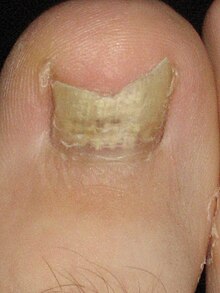Kakagya
- Wɔatwerɛ nsɛm wei ɛwɔ Asante kasa mu
| subclass of | dermatophytosis, onychomycosis, nail disease |
|---|---|
| has cause | infection |
| health specialty | dermatology |
| anatomical location | nail |
| ICD-9-CM | 681.9 |
Kakagya a wɔsan frɛ no Onychomycosis anaa also tinea unguium,[1] yɛ yadeɛ a ɛyɛ bɔwerɛ a ɛno nso, mmoawammoawa a yɛmfa yɛn ani nhunu wɔn na wɔde ba. [2]Obi nya bi a, ne bɔwerɛ no ahosuo tumi sesa yɛ sɛ akokɔ sradeɛ, tumtum anaa fitaa, bɔwerɛ no mu yɛ duru sene sɛdeɛ na ɛteɛ no. Ɛwɔ hɔ kyɛ a, na ɛrekame ayɛ sɛ bɔwerɛ no retu afiri honam no so. Ɛtumi yɛ nsa bɔwerɛ ne nan bɔwerɛ nyinaa.[3]
Ɛntaa nyɛ den mma wɔn a wɔwɔ kakagya wɔbɛnya aporɔporɔ.[4]
Nsɛnkyerɛnne
[sesa]

Nsɛnkyerɛnne a obi nya kakagya a, ɛtaa da adi ne sɛ bɔwerɛ no bɛyɛ den, n'ahosuo bɛsesa ayɛ biribi te sɛ tuntum, fitaa , ahaban mono anaa akokɔ sradeɛ. Bɔwerɛ no san nso tumi bubu. Ɛyɛ a na ɛrekame ayɛ sɛ deɛ ɛretu afiri honam no so. Sɛ wɔanhwɛ no yie a, honam a bɔwerɛ no tare so no tumi yɛ kuro.[5]Na ɛyɛ ya nso. Wɔn a wɔtaa de bɔwerɛ a kakagya ayɛ so no to nsuom no mpo deɛ, ɛyɛ a yaw no ano yɛ den sen obiara deɛ.[6] Ɛwɔ hɔ hyɛ nso a ɛtumi bɔn.[7] Sɛbyadeɛ no nkɔɔ n'anim a, ɛyɛ a ɛntaa mmɔn anaaɛntaa mfa nsunsuansoɔ biara mmerɛ nipadua no akwaa ahodoɔ no biara, gye sɛ yadeɛ no akyɛ aduru bunu mu.[8] Ebinom wɔ hɔ a wɔntaa nka wɔn ho nkɔ nipa mu esiane sɛdeɛ wɔn bɔwerɛ no ahosuo te no nti. Ɛyɛ a wɔtaa fɛre. Ɛyɛ den pa ara sɛ wɔn a wɔwɔ sa yadeɛ yi de wɔn bɔwerɛ bɛtoto nsuo muo mu.[9] Deɛ nti a ɛte saa no ne sɛ, wɔgu so de retoto nsuo no mu no, na yadeɛ no kɔ ara na ɛrekɔ n'anim. [10] Deɛ Ɛde Ba
Deɛ Ɛde Ba
[sesa]Deɛ ɛde kakagya ba no yɛ mmoawammoawa bi a wɔwɔ Kindom fungus Abusuakuo no mu. [11]
Kwan a Wɔfa So Sɔ Ano
[sesa]
Kakagya yɛ yadeɛ bi a, obi nya na wanyɛ aduro a, ɛrenkɔ da. Ne saa nti, wɔtaa faa nnuro a ɛtumi kum mmoawammoawa a wɔde yadeɛ no ba no. Saa nnuro yi tumi yɛ deɛ wɔde yɛ bɔwerɛ no so anaa deɛ wɔnom .[12] [13]
[sesa]Nnuro No Bi
[sesa]M Nnuro a ɛsa kakagya no mu ɔha nkyekyɛmu aduɔson nsia na wɔnom. Ɛna ɔha nkyekyɛmu aduonu nan a aka no nso yɛ deɛ wɔde sera beaeɛ a yadeɛ no ayɛ no. Nhwɛsoɔ no bi ne itraconazole a wɔkyerɛ sɛ n'adwuma ɛyɛ no gyina ɔha nkyekyɛmu aduosia. Ebi nso ne, fluconazole a wɔkyerɛ sɛ n'adwuma a ɛyɛ no gyina ɔha nkyekyɛmu aduanan-nwɔtwe. [14]Deɛ nnuro yi tumi yɛ no bi ne sɛ ɛma ekuro a ɛwɔ mmɔwerɛ no mu no wu. Ɛma mmɔwerɛ no fifiri bio. Na afei, ɛtumi da honam no so yie. [15] Ebi wɔ hɔ a, wɔtu mmɔwerɛ a n'ahosuo asesa no.[16] Nnuro mmienu a yɛaka ho asɛm yi nyinaa yɛ deɛ ayarewhɛfoɔ agye ato mu. Nanso yɛwɔ bi wɔ hɔ a wɔnnye ntoo mu. Baako ne Ketoconazole. Yei yɛ deɛ wɔnom no mu baako[17] [18] [19]
Baabi a Menyaa Mmoa Firiiɛ
[sesa]- ↑ Rodgers P, Bassler M (February 2001). "Treating onychomycosis". American Family Physician. 63 (4): 663–72, 677–8. PMID 11237081.
- ↑ Dyanne P. Westerberg, Michael J. Voyack (2013-12-01), "Onychomycosis: Current trends in diagnosis and treatment", American Family Physician, vol. 88, no. 11, pp. 762–770, ISSN 1532-0650, PMID 24364524, retrieved 2024-06-15
- ↑ Dyanne P. Westerberg, Michael J. Voyack (2013-12-01), "Onychomycosis: Current trends in diagnosis and treatment", American Family Physician, vol. 88, no. 11, pp. 762–770, ISSN 1532-0650, PMID 24364524, retrieved 2024-06-15
- ↑ n2:1532-0650 - Search Results, retrieved 2024-06-15
- ↑ n2:1532-0650 - Search Results, retrieved 2024-06-15
- ↑ NHS Choices: Symptoms of fungal nail infection
- ↑ Mayo clinic: Nail fungus
- ↑ Nhwɛsoɔ:EMedicine
- ↑ n2:1532-0650 - Search Results, retrieved 2024-06-15
- ↑ Szepietowski JC, Reich A (July 2009). "Stigmatisation in onychomycosis patients: a population-based study". Mycoses. 52 (4): 343–9. doi:10.1111/j.1439-0507.2008.01618.x. PMID 18793262. S2CID 26932678.
- ↑ Chi CC, Wang SH, Chou MC (November 2005). "The causative pathogens of onychomycosis in southern Taiwan". Mycoses. 48 (6): 413–20. doi:10.1111/j.1439-0507.2005.01152.x. PMID 16262878. S2CID 43885361.
- ↑ "MOB-015". Retrieved 13 June 2024.
- ↑ "Efficacy and safety of topical terbinafine 10% solution (MOB-015) in the treatment of mild to moderate distal subungual onychomycosis: A randomized, multicenter, double-blind, vehicle-controlled phase 3 study". Retrieved 12 June 2024.
- ↑ Hadeer Sinawe, Damian Casadesus (2024), "Ketoconazole", StatPearls, Treasure Island (FL): StatPearls Publishing, PMID 32644647, retrieved 2024-06-15
- ↑ Elewski BE (July 1998). "Onychomycosis: pathogenesis, diagnosis, and management". Clinical Microbiology Reviews. 11 (3): 415–29. doi:10.1128/CMR.11.3.415. PMC 88888. PMID 9665975.
- ↑ Elewski BE, Hay RJ (August 1996). "Update on the management of onychomycosis: highlights of the Third Annual International Summit on Cutaneous Antifungal Therapy". Clinical Infectious Diseases. 23 (2): 305–13. doi:10.1093/clinids/23.2.305. PMID 8842269.
- ↑ "Nizoral (ketoconazole) Oral Tablets: Drug Safety Communication - Prescribing for Unapproved Uses including Skin and Nail Infections Continues; Linked to Patient Death". FDA. 19 May 2016. Retrieved 20 May 2016.
- ↑ Haugh M, Helou S, Boissel JP, Cribier BJ (July 2002). "Terbinafine in fungal infections of the nails: a meta-analysis of randomized clinical trials". The British Journal of Dermatology. 147 (1): 118–21. doi:10.1046/j.1365-2133.2002.04825.x. PMID 12100193. S2CID 19682557.
- ↑ Baran R, Faergemann J, Hay RJ (November 2007). "Superficial white onychomycosis--a syndrome with different fungal causes and paths of infection". Journal of the American Academy of Dermatology. 57 (5): 879–82. doi:10.1016/j.jaad.2007.05.026. PMID 17610995.
